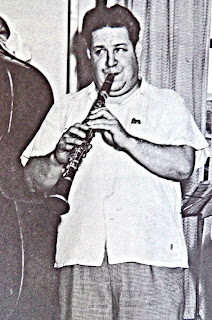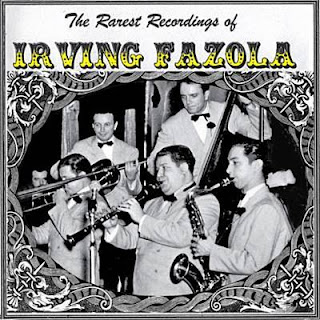Irving Fazola (December 10, 1912 – March 20, 1949) was a great American jazz clarinetist particularly skilled at counterpoint and playing the blues.
Fazola or Faz was born in New Orleans, Louisiana as Irving Henry
Prestopnik. Little is known about his father. He was raised by his mother, Camille (maiden name unknown). A few lessons on piano made no impression, but after buying a saxophone and later a clarinet, Fazola became immersed in music and showed a capacity for learning and a talent entirely lacking in his formal education. He studied mainly with Santo Giuffre, as well as with Jean Paquay, the leading teachers of white clarinetists in New Orleans at the time. Paquay had come to New Orleans in 1909 to play in the orchestra at the French Opera House.
Prestopnik. Little is known about his father. He was raised by his mother, Camille (maiden name unknown). A few lessons on piano made no impression, but after buying a saxophone and later a clarinet, Fazola became immersed in music and showed a capacity for learning and a talent entirely lacking in his formal education. He studied mainly with Santo Giuffre, as well as with Jean Paquay, the leading teachers of white clarinetists in New Orleans at the time. Paquay had come to New Orleans in 1909 to play in the orchestra at the French Opera House.
Some believe that Paquay's famous student got his nickname from being constantly told to play "Do-re-mi-fa-sol-la ..." Others claim that Irving was given his stage name by fellow New Orleanian Louis Prima. Prima would tell Faz that he was "Fazola" Italian for "Beans." That being Jazz talk for being cool.
Particularly skilled at counterpoint and playing the blues, Irving Fazola began to study C melody sax and clarinet at 13. Influenced early on by Leon Roppolo, who Fazola continued to idolize throughout his life, Fazola was playing professionally by age 15.
A graduate of Warren Easton High School in New Orleans, he played with some of the best bands in the country, including Bob Crosby, Phil Harris, Horace Heidt, Gus Arnheim, Claude Thornhill and Teddy Powell.
 When the touring Ben Pollack band came through New Orleans in 1935 Fazola joined the band and toured the country and played residencies in New York City and Chicago with them. After brief stints with Gus Arnheim, Glenn Miller and time back in New Orleans he joined the Bob Crosby band in 1938. His work with Crosby brought him national fame.
When the touring Ben Pollack band came through New Orleans in 1935 Fazola joined the band and toured the country and played residencies in New York City and Chicago with them. After brief stints with Gus Arnheim, Glenn Miller and time back in New Orleans he joined the Bob Crosby band in 1938. His work with Crosby brought him national fame. In 1939 and 1940, he was rated the No. 1 clarinetist in the nation. In 1940 and 1941, he won the Down Beat poll for "Best Jazz Clarinetist," beating out superstars Benny Goodman and Artie Shaw.
After leaving Crosby's band in 1940, he alternated between playing with various groups in New York, Chicago, and New Orleans (including a stint with George Brunies at the Famous Door). After seven years away, Faz returned in poor health to New Orleans in 1942.
While some of his fellow musicians urged Fazola that greater fame and fortune awaited him in the big cities up north, Fazola said he was more comfortable in his home town with its wonderful food (which he ate in great quantities, becoming ever more obese). According to Pete Fountain, for whom Fazola was one of his two foremost idols, Faz also drank heavily, which contributed to his weight and his early death.
While some of his fellow musicians urged Fazola that greater fame and fortune awaited him in the big cities up north, Fazola said he was more comfortable in his home town with its wonderful food (which he ate in great quantities, becoming ever more obese). According to Pete Fountain, for whom Fazola was one of his two foremost idols, Faz also drank heavily, which contributed to his weight and his early death.
In New Orleans Faz had a radio show on WWL, sometimes led his own band, and worked with bandleaders Tony Almerico and Louis Prima.
 Faz ola died of a heart attack at home in New Orleans in 1949 at the age of 36 on the evening he was to lead the "Dixieland Jamboree" at the French Quarter's Parisian Room. Members of his local jazz band were pallbearers at his funeral.
Faz ola died of a heart attack at home in New Orleans in 1949 at the age of 36 on the evening he was to lead the "Dixieland Jamboree" at the French Quarter's Parisian Room. Members of his local jazz band were pallbearers at his funeral.New Orleans jazz musician Pete Fountain gives much credit to Irving Fazola for his wonderful clarinet sound. When Fountain took up the clarinet as a young man, he spent many hours listening to recordings of Faz's music. And when Pete Fountain himself attended Warren Easton and joined the band, he told people that he had learned how to play from Irving Fazola. Fountain sat in for Faz at the Opera House the night Faz died, specifically requested because he played like Faz.
Fountain's estate continues to hold Faz's clarinet, but Fountain said that the odour of garlic that comes from the horn when it warms up makes it virtually impossible to play even after having been reconditioned by the factory.
Fountain's estate continues to hold Faz's clarinet, but Fountain said that the odour of garlic that comes from the horn when it warms up makes it virtually impossible to play even after having been reconditioned by the factory.
It is an Albert System clarinet, on which the fingers are stretched out more than on the Boehm system clarinet that Fountain played. The distinctive woody (or "fat") Fountain sound, however, comes from the crystal mouthpiece he played with since 1949, his first having been Fazola's own, given to him along with the clarinet by Fazola’s mother after Faz's death, because she had heard him play and noted how he played like her son. Pete played crystal mouthpieces ever after.
(Edited from Wikipedia & K. Jacob Ruppert)





